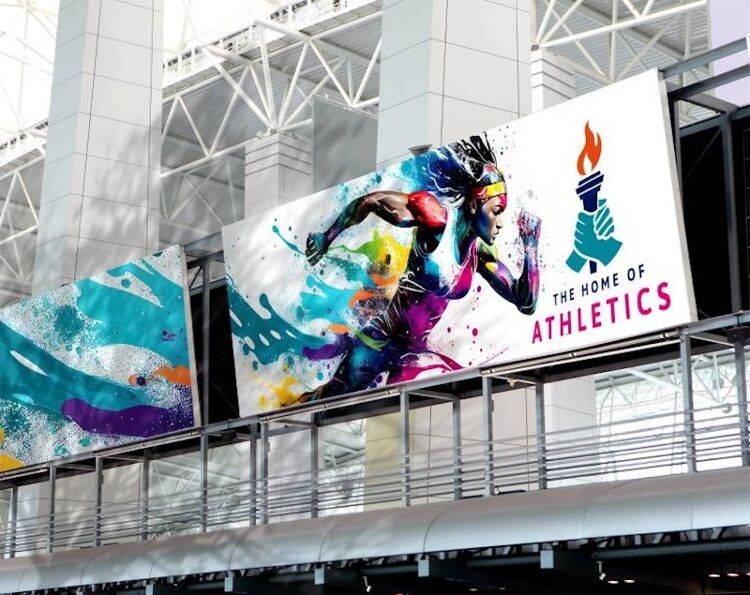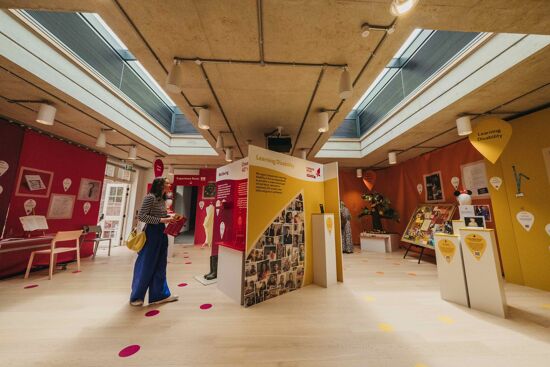Sustainable options for indoor displays

Nessan Cleary shares how Large format printing is not always seen as the most environmentally conscious area yet there are plenty of sustainable options and opportunities for indoor applications.
The natural world is not very kind to printed displays. The UV rays in sunlight cause pigments to fade, while rain can damage substrates and wind can pull down signs. So outdoor displays need to be sturdy, and that often leads to challenges when it comes to sourcing sustainable media and recycling those graphics.
None of these concerns apply to indoor graphics so there’s no reason for not considering the sustainability of those displays, which gives us a chance to be kind to the natural world. If anything, with many companies having to audit their sustainability, customers are increasingly asking print service providers to offer them sustainable options. And as the tide is turning in favour of using sustainable materials, so further developments and higher volumes are also leading to lower costs, particularly for indoor applications, so that price is no longer the turn-off that it might have been a few years ago.
Perhaps the first place to start is, what do we mean by sustainable? Ideally, this should mean using natural materials that are easily replaced, such as wood from soft trees such as pine that can be grown fairly quickly. Most plastics on the other hand have a petro-chemical base that ultimately depends on oil, which is not replaceable though some are easier to recycle and to reuse than others.
Another measure of sustainability is the ease with which those products can be recycled. There’s nothing environmentally-friendly about landfill sites and plenty of materials that can be recycled. Equally, some materials are marketed as eco-friendly because they contain some degree of recycled material but that doesn’t necessarily mean that they themselves can be recycled.
Some materials, such as rigid boards, are sold on the basis that the graphic can be replaced and the board reused multiple times. This is better than a single-use board, and might be the most cost-effective option for outdoor displays, but is less of an argument for indoor graphics.
Some print technologies are better-suited for indoor applications. The most obvious is aqueous inks, which are capable of achieving a wide colour gamut. Several vendors, including HP, Canon and Epson, sell these printers in widths ranging from 600mm to 1.6m, with print resolutions up to 1200 dpi, suitable for close-up viewing.
Resin printers, also known as latex, use water-based inks that are relatively easy to recycle. Again, there’s a good choice from HP, Epson and Ricoh and these printers have the further advantage that they can also be used for outdoor applications.
UV inks, though widely used, are generally less suited for indoor applications because they produce a noticeable odour that can linger for a week or more.
 This counter has been built with Reboard, which is suitable for rigid POS displays
This counter has been built with Reboard, which is suitable for rigid POS displays
Substrates
In terms of substrates, there are a number of different types of materials that are more sustainable than others. Textiles, including canvas, offer one of the easiest routes to recycling and are extremely versatile when it comes to display graphics, being suitable for banners, flags, backlit displays and wall coverings. You can print direct to some coated textiles using a standard resin or latex printer or even a dedicated direct-to-fabric printer.
However, a better alternative would be to use a dye sublimation printer, which will print to a transfer paper, and then use a heat press to sublimation the image to the fabric. This will drive the ink into the fibres of the fabric, ensuring vibrant colours and a natural feel to the graphic.
Textiles also have a further advantage in that they are light and easy to deliver. In most cases they can be posted to a client, and the client can install the graphic themselves, which saves on both the cost and the environmental footprint associated with transport. They are also easily coated with a flame retardant solution to meet fire safety standards.
Paper and thick card is a sustainable and easily recycled media that’s suitable for posters and some indoor signage though it will usually need to be held in a frame or attached to something like a wall. However, there are also plenty of paper-based cardboard substrates that are equally as environmentally-friendly and offer good rigidity for standalone displays. Paper-based substrates should come with FSC-, or Forest Stewardship Council, certification to guarantee to you and your clients that they have been sourced sustainably.
There are a number of rigid cardboard boards available, that are good for dump boxes and point of sale displays and dispensers. These mostly use a core made of paper arranged in a honeycomb pattern sandwiched between two printable card faces. One of the best known of these is Dufaylite, which makes Ultraboard for the sign and display market. This is said to have a dense core that is suitable for V-cutting and is available in different sizes up to 3000 x 1600mm. It’s FSC-certified and carbon neutral.
The Swedish form Swedboard makes a sustainable paper-based rigid board, though its paper core uses a different pattern to the usual honeycomb that it claims offers better rigidity and less dust when cut. Reboard, also from Sweden, offers a range of boards with a similar structure but a choice of different finishes.
The choice is more limited when it comes to banner materials though MTX Display sells a biodegradable Kavalan Eco banner that’s said to be suitable for both indoor and outdoor use. It can be welded but does not contain any PVC and is said to be 50 percent lighter than PVC. It has a water-based, light biodegradable coating that contains enzymes that encourage decomposition so that it can breaks down naturally in a landfill site.
There are also some films that do not use PVC though these mainly just use a different form of plastic such as Polypropylene, PET or polyester. These materials are usually easier to recycle than PVC, and therefore more environmentally-friendly, though not as sustainable as textiles or wood-based products. That said, some applications can only be fulfilled with a film-based graphic and these materials are a significant improvement over PVC.
It obviously follows that adding any further effects, such as laminating a textured surface to the substrate, will make it harder to recycle the graphic as well as increasing its carbon footprint, unless you are using the same PVC-free material as the print.
In conclusion, the need for all of us to be more sustainable in our businesses and our daily lives is here to stay. The days of sending large volumes of used plastic display graphics to landfill are over. But large format print shops can turn this to their advantage by being seen to champion sustainability and offering a consultation service to help their clients realise their own green goals.
Discover the latest innovations in large format printing at FESPA Global Print Expo 2024, Europe’s leading print and signage exhibition. Taking place from 19th – 22nd March 2024 at RAI Amsterdam, Netherlands. Register here to visit and use code FESJ404.
Interested in joining our community?
Enquire today about joining your local FESPA Association or FESPA Direct
Recent news
.png?width=550)
Why are FESPA events the ideal place for visionaries to meet? With Harold Klaren from EFKA
We speak to Harold Klaren, International Sales Manager at EFKA about visionaries in print. Harold shares why he believes FESPA events are the ideal place for visionareis to meet.

NSELED to showcase Innovation and transformation at European Sign Expo 2025
NSELED Europe, part of leading LED display technology provider NSE, will welcome visitors to its stand at the European Sign Expo 2025. Ahead of the event, we speak with Daniele Rocca, principal chief executive officer at NSELED Europe, about what to expect from the company as the official ‘Digital Screen Partner’ of the event.

Why the Future of Print Is Personal – and What That Means for Your Business
Minna Philipson, CMO at Gelato shares how the future of print is personal, driven by demands for tailored, localised, and on-demand products. Businesses must adapt, embracing software to streamline operations and building customer-centric brands. Personalisation is key to connection, requiring emotional storytelling and flexible operations to thrive in the evolving market.

The latest sustainable solutions in non-digital signage
While by no means a new concept in the market, sustainability is becoming an increasingly important part of daily life for sign-making businesses. Here, Rob Fletcher shares some of the non-digital materials to help companies become more planet friendly.